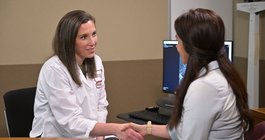
January 10, 2023
Infertility affects 10 to 15 percent of all couples, according to the American Society for Reproductive Medicine. That makes it one of the most common diseases among people from ages 20 to 45.
Despite that, however, infertility is a very personal matter to people who are diagnosed with it. If you’re among them, here is some information to help you navigate your options.
Infertility is defined as the inability to conceive after 12 months of unprotected sex, or, for women who are 35 or older, six months of unprotected sex. Women who repeatedly miscarry also are considered to be infertile.
Eighty-five percent of all couples with normal fertility conceive within a year of trying. If they can’t conceive within a year, their chance of conceiving drops each month afterwards. For women, the longer they have unprotected sex without conceiving, the more likely it is they will need medical treatment to get pregnant.
Roughly one third of all infertility diagnoses in couples are attributable to men. Another third are attributable to women. The remainder can’t be attributed.
Male infertility can be caused by physical problems with the testicles, unhealthy sperm, a low sperm count, or blockages in the ducts that carry sperm. Other causes include a history of high fevers or mumps, hormone problems, genetic disorders, and lifestyle or environmental factors.
Female infertility can be due to physical problems, hormone problems, disease, being overweight or underweight, lifestyle or environmental factors, and age. It typically results from problems producing eggs.
In primary ovarian insufficiency or premature ovarian failure, the ovaries stop working before the person turns 40. In polycystic ovary syndrome, the ovaries or adrenal glands produce more male hormones than normal. That causes cysts, which are fluid-filled sacs, to grow on the ovaries.
If you think you and/or your partner might be infertile, the first step to take is to see your doctor. They likely will refer you to a fertility specialist. Obstetricians/gynecologists (OB/GYNs) or reproductive endocrinologists evaluate women whereas urologists evaluate men.
On your first visit to a fertility specialist, you likely will be required to provide your medical history and undergo a physical exam.
Women will be asked about their menstrual cycles and whether they have abnormal vaginal bleeding or discharges, pelvic pain, and disorders such as thyroid disease that can affect reproduction.
Both partners will be asked if they’ve been involved in past pregnancies and, if so, what their outcomes were, as well as whether anyone in their families has birth defects. They also will be asked about their sexual histories, any illnesses or surgeries they may have had, and their use of medications, tobacco, alcohol, marijuana, and illegal drugs.
Men may undergo semen analyses, blood tests to measure levels of male reproductive hormones, and ultrasound exams of the testicles.
Women may undergo urine tests to see if and when they ovulate, and blood tests to measure their hormones, their thyroid function, and their egg supply. They also may undergo ultrasound exams and other imaging procedures, including hysteroscopies and laparoscopies.
Infertility evaluations usually can be completed within a few menstrual cycles.
If you and/or your partner are diagnosed as infertile, you can undergo treatments designed to cure the cause of the infertility.
Women may be prescribed medicine to stimulate their ovaries. Alternatively, they may need to undergo surgery to address problems with their fallopian tubes or deal with endometriosis, fibroids, polyps, or scarring, all of which can affect fertility.
Men may be treated with medicine, typically to address erectile dysfunction or problems ejaculating. They also may need to undergo surgery to address enlarged veins in their scrotum or blockages in the tubes that carry sperm.
If those treatments fail, there’s always assisted reproductive technology, or ART. It includes:
• Intrauterine insemination, or IUI, in which healthy sperm is inserted into the uterus around the time of ovulation.
• In-vitro fertilization, in which eggs are removed and fertilized in a laboratory, and the resulting embryo is implanted into the uterus.
• Third-party assisted ART, in which another person assists a couple by donating eggs or sperm, or by carrying their baby to term.
Unfortunately, infertility treatments don’t always work. And the hormones and egg-stimulating medications that in-vitro fertilization requires can affect emotional and physical health.
Getting counseling or joining a support group can help people deal with the emotional difficulties resulting from infertility.
And those who can’t have children themselves, but still want them, may choose to consider adoption.